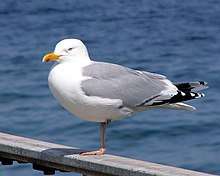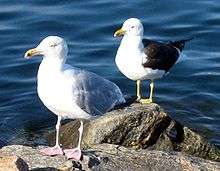Larus
Larus is a large genus of gulls with worldwide distribution (by far the greatest species diversity is in the Northern Hemisphere). The genus name is from Ancient Greek laros (λάῥος) or Latin larus, which appears to have referred to a gull or other large seabird.[1]
| Larus | |
|---|---|
 | |
| European herring gull (Larus argentatus) | |
| Scientific classification | |
| Kingdom: | Animalia |
| Phylum: | Chordata |
| Class: | Aves |
| Order: | Charadriiformes |
| Family: | Laridae |
| Subfamily: | Larinae |
| Genus: | Larus Linnaeus, 1758 |
| Species | |
|
See list | |
Many of its species are abundant and well-known birds in their ranges. Until about 2005–2007, most gulls were placed in this genus, but this arrangement is now known to be polyphyletic, leading to the resurrection of the genera Ichthyaetus, Chroicocephalus, Leucophaeus, and Hydrocoloeus (this last had been recognized more often than the other genera) for several species traditionally included in Larus.
They are in general medium to large birds, typically grey or white, often with black markings on their heads or wings. They have stout, longish bills and webbed feet.
The taxonomy of the large gulls in the herring and lesser black-backed complex is very complicated, with different authorities recognising between two and eight species.
Systematics and evolution
List of species in taxonomic order
- Pacific gull, L. pacificus
- Belcher's gull, L. belcheri
- Olrog's gull, L. atlanticus
- Black-tailed gull, L. crassirostris
- Heermann's gull, L. heermanni
- Common gull or mew gull, L. canus
- Ring-billed gull, L. delawarensis
- California gull, L. californicus
- Great black-backed gull, L. marinus
- Kelp gull, L. dominicanus (called southern black-backed gull or karoro in New Zealand)
- Cape gull, L. d. vetula
- Glaucous-winged gull, L. glaucescens
- Western gull, L. occidentalis

- Yellow-footed gull, L. livens
- Glaucous gull, L. hyperboreus
- Iceland gull, L. glaucoides
- Kumlien's gull, L. g. kumlieni
- Thayer's gull, L. g. thayeri
- European herring gull, L. argentatus
- American herring gull, L. smithsonianus
- Yellow-legged gull, L. michahellis
- Caspian gull, L. cachinnans
- Vega gull, L. vegae (or East Siberian gull)
- Birula's gull, L. v. birulai
- Mongolian gull, L. v. mongolicus
- Armenian gull, L. armenicus
- Slaty-backed gull, L. schistisagus
- Lesser black-backed gull, L. fuscus
- Heuglin's gull, L. f. heuglini
Fossils of Larus gulls are known from the Middle Miocene, about 20-15 million years ago; allocation of earlier fossils to this genus is generally rejected nowadays. Biogeography of the fossil record suggests that the genus evolved in the northern Atlantic and spread globally during the Pliocene, when species diversity seems to have been highest, as with most seabirds.
- Larus sp. (Grund Middle Miocene of Austria)
- Larus sp. (Middle Miocene of Romania) [2]
- Larus sp. (Late? Miocene/Early Pliocene of Lee Creek Mine, U.S.) - several species [2]
- Larus elmorei (Bone Valley Early/Middle Pliocene of the southeastern U.S.)
- Larus lacus (Pinecrest Late Pliocene of the southeastern U.S.)
- Larus perpetuus (Pinecrest Late Pliocene of the southeastern U.S.)
- Larus sp. (San Diego Late Pliocene of the southwestern U.S.)
- Larus oregonus (Late Pliocene - Late Pleistocene of the west-central U.S.)
- Larus robustus (Late Pliocene - Late Pleistocene of the west-central U.S.)
- Larus sp. (Lake Manix Late Pleistocene of the western U.S.)
"Larus" raemdonckii (Early Oligocene of Belgium) is now at least tentatively believed to belong in the procellariiform genus Puffinus. "L." elegans (Late Oligocene?/Early Miocene of St-Gérand-le-Puy, France) and "L." totanoides (Late Oligocene?/Early Miocene of southeastern France) are now in Laricola, while "L." dolnicensis (Early Miocene of the Czech Republic) was actually a pratincole; it is now placed in Mioglareola.
The Early Miocene "Larus" desnoyersii (southeastern France) and "L." pristinus (John Day Formation, Willow Creek, U.S.) probably do not belong in this genus; the former may be a skua.[3]
Ring species

The circumpolar group of Larus gull species has often been cited as a classic example of the ring species. The range of these gulls forms a ring around the North Pole. The European herring gull, which lives primarily in Great Britain, can hybridize with the American herring gull (living in North America), which can also interbreed with the Vega or East Siberian gull, the western subspecies of which, Birula's gull, can hybridize with Heuglin's gull which, in turn, can interbreed with the Siberian lesser black-backed gull (all four of these live across the north of Siberia). The last is the eastern representative of the lesser black-backed gulls back in northwestern Europe, including Great Britain. However, the lesser black-backed gulls and herring gull are sufficiently different that they rarely interbreed; thus, the group of gulls forms a continuum except in Europe, where the two lineages meet. However, a recent genetic study has shown that this example is far more complicated than presented here, and probably does not constitute a true ring species.[4]
References
- Jobling, James A (2010). The Helm Dictionary of Scientific Bird Names. London: Christopher Helm. p. 219. ISBN 978-1-4081-2501-4.
- Olson, Storrs L. (1985): Section X.D.2.j. Laridae. In: Farner, D.S.; King, J.R. & Parkes, Kenneth C. (eds.): Avian Biology 8: 181-182. Academic Press, New York.
- (Olson, 1985).
- Liebers, Dorit; de Knijff, Peter & Helbig, Andreas J. (2004). "The herring gull complex is not a ring species". Proc. Roy. Soc. B. 271 (#1542): 893–901. doi:10.1098/rspb.2004.2679. PMC 1691675.Supplemental material: Electronic appendices